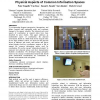HICSS
2011
IEEE
13 years 4 months ago
2011
IEEE
With increasing proliferation of virtual environments for serious work as well as play, we are confronted by new challenges pertaining to how such environments can be leveraged to...
CHI
2010
ACM
13 years 10 months ago
2010
ACM
To accommodate frequent emergencies, interruptions, and delays, hospital staff continually make and coordinate changes to the surgery schedule. The technical and social aspects of...
JUCS
2000
14 years 6 days ago
2000
: Embedded Computer-based Systems are becoming highly complex and hard to implement because of the large number of concerns the designers have to address. These systems are tightly...
ENTCS
2010
14 years 15 days ago
2010
The cost of deploying a ubiquitous system to enhance a physical environment is likely to be considerable. The success of its deployment is highly dependent on its context: the phy...
HCI
2007
14 years 1 months ago
2007
Teams performing physical tasks must often be distributed in space, and are often organized hierarchically. This means that systems to support collaboration between members must ac...
FIW
2007
14 years 1 months ago
2007
Feature interaction detection in the context of systems that are highly integrated into their environment, such as embedded or software-intensive systems, is different from classi...
SPATIALCOGNITION
2000
Springer
14 years 4 months ago
2000
Springer
An approach to high-level interaction with autonomous robots by means of schematic maps is outlined. Schematic maps are knowledge representation structures to encode qualitative s...
SPATIALCOGNITION
2000
Springer
14 years 4 months ago
2000
Springer
Schematic maps are effective tools for representing information e physical environment; they depict specific information in an abstract way. This study concentrates on spatial aspe...
DEXAW
2004
IEEE
14 years 4 months ago
2004
IEEE
In Autonomic Computing, an application needs to be aware of its environment. While the term "environment" is not normally understood as being a physical environment, in ...
HICSS
2003
IEEE
14 years 5 months ago
2003
IEEE
Moving around our physical environment, we are surrounded and interact with information that exhorts and stimulates us to buy things. For most of us, not all of these impulses are...





